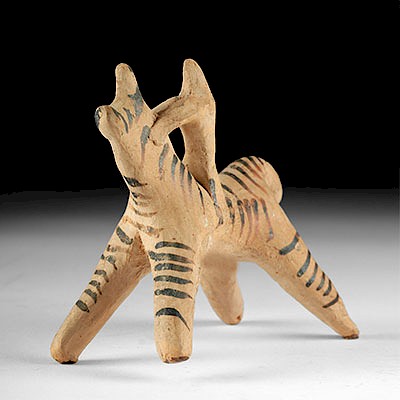Roman Holy Land Bronze Oil Lamp w/ Dolphin Handle
Lot 96
About Seller
Artemis Gallery
686 S Taylor Ave, Ste 106
Louisville, CO 80027
United States
Selling antiquities, ancient and ethnographic art online since 1993, Artemis Gallery specializes in Classical Antiquities (Egyptian, Greek, Roman, Near Eastern), Asian, Pre-Columbian, African / Tribal / Oceanographic art. Our extensive inventory includes pottery, stone, metal, wood, glass and textil...Read more
Estimate:
$1,200 - $1,800
Absentee vs Live bid
Two ways to bid:
- Leave a max absentee bid and the platform will bid on your behalf up to your maximum bid during the live auction.
- Bid live during the auction and your bids will be submitted real-time to the auctioneer.
Bid Increments
| Price | Bid Increment |
|---|---|
| $0 | $25 |
| $300 | $50 |
| $1,000 | $100 |
| $2,000 | $250 |
| $5,000 | $500 |
| $10,000 | $1,000 |
| $20,000 | $2,500 |
| $50,000 | $5,000 |
| $100,000 | $10,000 |
| $200,000 | $20,000 |
About Auction
By Artemis Gallery
Oct 25, 2018
Set Reminder
2018-10-25 11:00:00
2018-10-25 11:00:00
America/New_York
Bidsquare
Bidsquare : Antiquities from Egypt, Greece, Italy, Asia
https://www.bidsquare.com/auctions/artemis-gallery/antiquities-from-egypt-greece-italy-asia-3538
Featuring Egyptian, Greek, Roman, Etruscan, Near Eastern, plus Asian art from Central and Far East. If you love the classics, this is the sale for you. Artemis Gallery info@artemisgallery.com
Featuring Egyptian, Greek, Roman, Etruscan, Near Eastern, plus Asian art from Central and Far East. If you love the classics, this is the sale for you. Artemis Gallery info@artemisgallery.com
- Lot Description
Roman, Holy Land, late Imperial Period, ca. 4th to early 5th century CE. A lovely bronze oil lamp cast via the lost wax (cire perdue) method with a projecting ring base attached with a small tang, a rounded body, a concave discoid wick spout, a pair of perforated lugs for holding a lid, and a tall handle in the shape of a dolphin. Bronze oil lamps like this were typically set atop a tall bronze stand so that the light it produced could be more evenly dispersed throughout a room. Covered in thick layers of matte green and dark brown patina. Size: 6.375" L x 2.25" W x 3.625" H (16.2 cm x 5.7 cm x 9.2 cm).
Some scholars have noted that bronze lamps, with their increased cost over pottery lamps, were a type of heirloom, most likely reserved for the richest households. Bronze lamps are theorized to have been in a family for at least three generations because of their expense. They could also be recast to include new additions - like crosses or new lids - to suit changing styles. This particular type of lamp proved popular, and several production centers for the style arose; ultimately, they were distributed widely throughout the Eastern Roman Empire, reaching Asia Minor, Morocco, and even Central Europe.
For a stylistically-similar example with a cross-shaped handle resting on a stand, please see The Metropolitan Museum of Art, accession number 28.138a, b: https://www.metmuseum.org/art/collection/search/466702
Provenance: private Houston, Texas, USA collection
All items legal to buy/sell under U.S. Statute covering cultural patrimony Code 2600, CHAPTER 14, and are guaranteed to be as described or your money back.
A Certificate of Authenticity will accompany all winning bids.
We ship worldwide and handle all shipping in-house for your convenience.
#132933Original lid is missing. Surface wear and abrasions commensurate with age, small chips and nicks to wick spout, body, base, and handle, with fading to some details, and light roughness across most surfaces. Light earthen deposits and great patina throughout.Condition
- Shipping Info
-
All shipping is handled in-house for your convenience. Your invoice from Artemis Gallery will include shipping calculation instructions. If in doubt, please inquire BEFORE bidding for estimated shipping costs for individual items.
-
- Buyer's Premium



 EUR
EUR CAD
CAD AUD
AUD GBP
GBP MXN
MXN HKD
HKD CNY
CNY MYR
MYR SEK
SEK SGD
SGD CHF
CHF THB
THB
















